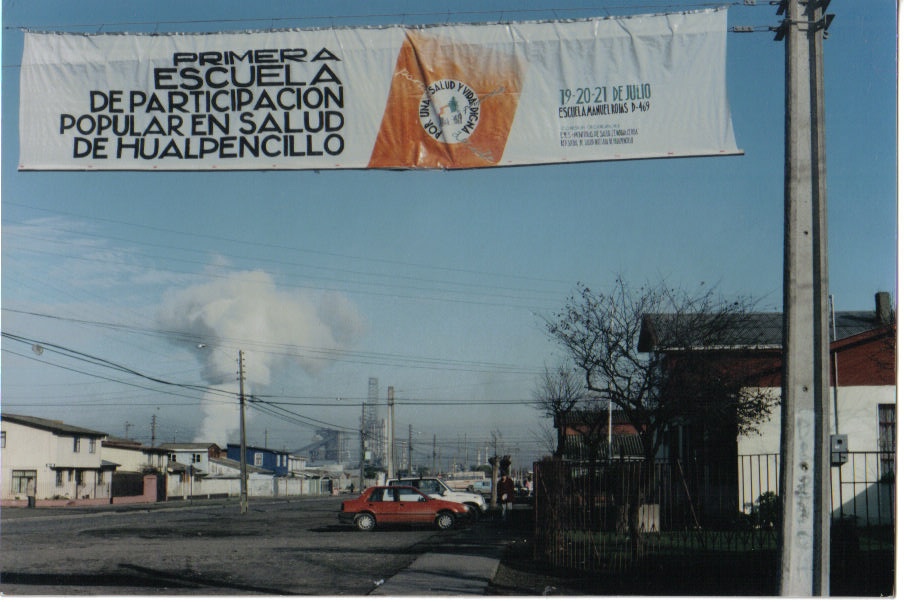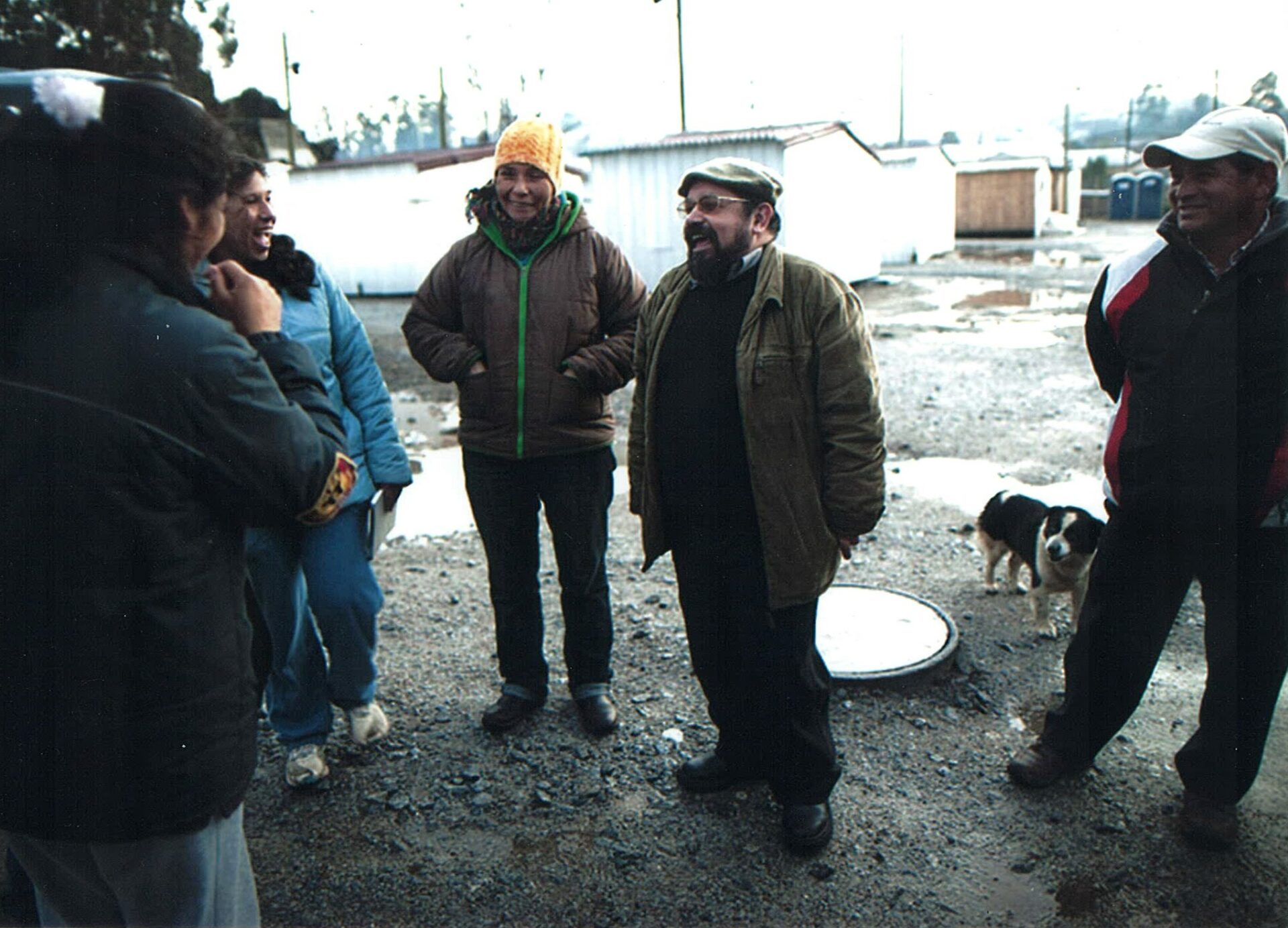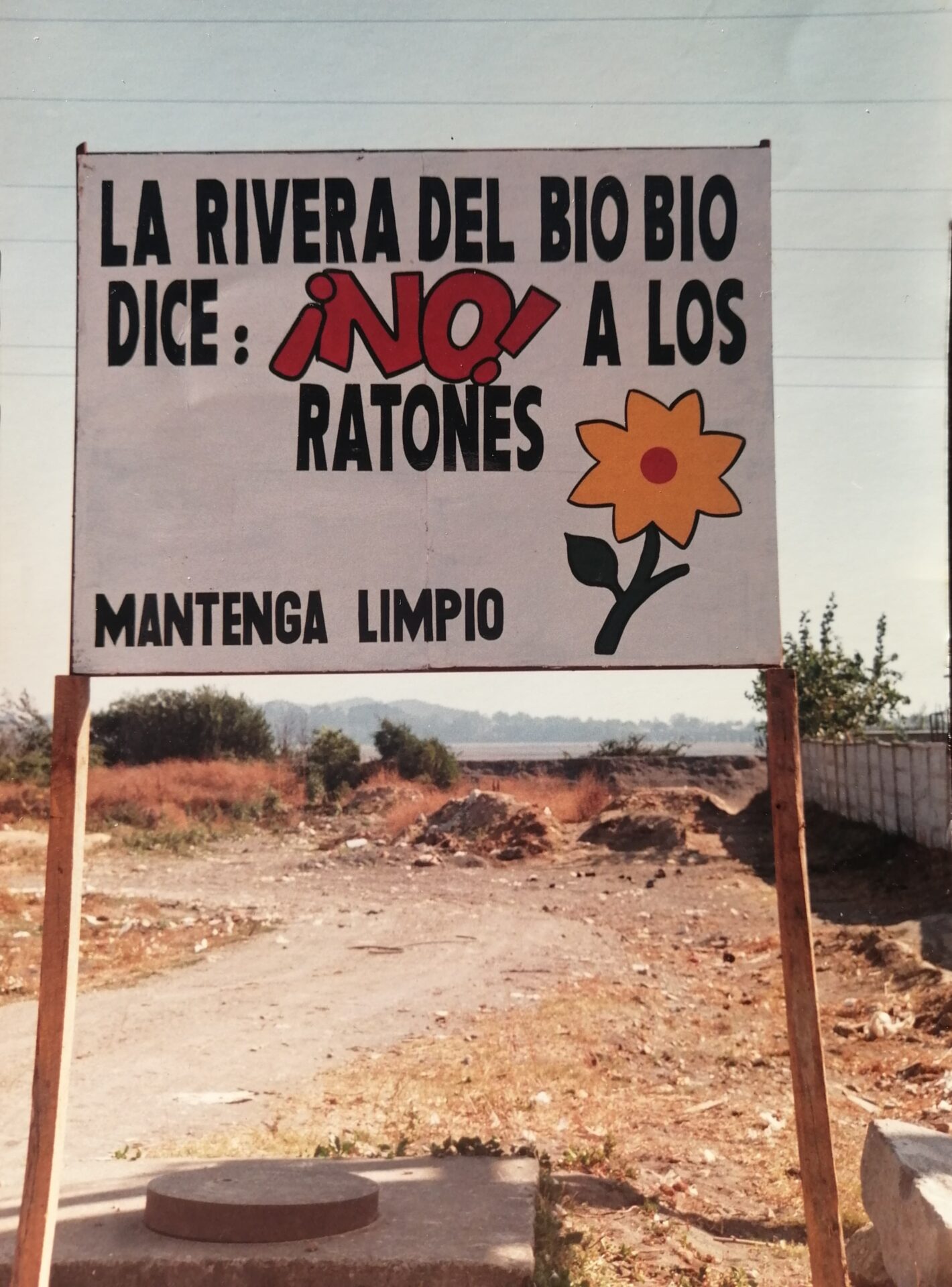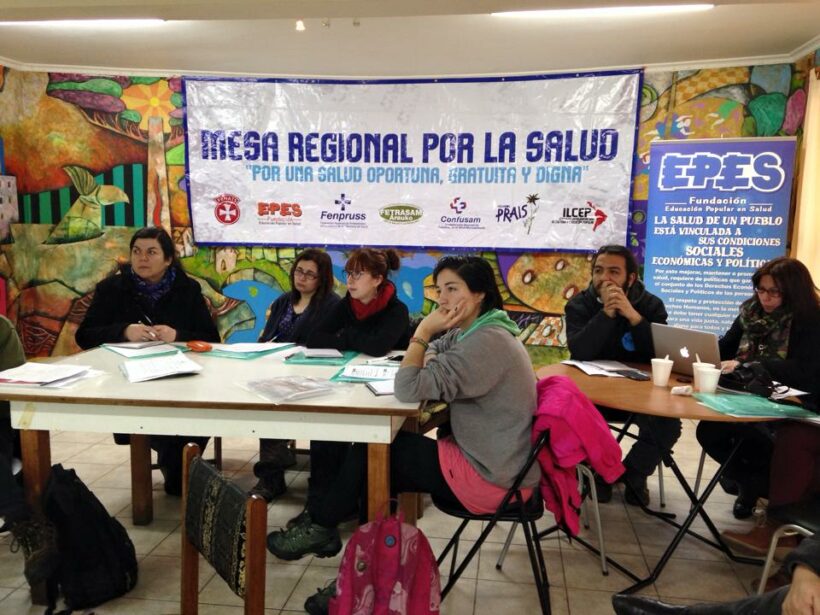By Maxine Lowy
Along the north shore of the Biobío River, in the Chilean southcentral city of Concepción, illegal waste dumps and overgrown bushes proliferated. A short distance from there were modest neighborhoods where families crowded in flimsy houses. Rodents, unsanitary conditions, and winter floods were commonplace. But people resigned themselves to their precarious existence- after all, 10 years had passed since the dictatorship invaded their lives and no one dared complain.
This began to change In 1983. Overcoming organizational fragmentation, fear and institutional violence, people organized monthly protests throughout the country. A student movement erupted in Concepción, and in November in that city a worker called Sebastián Acevedo set himself ablaze in front of the cathedral, in desperation over the arbitrary detention of his son and daughter, Hundreds of community organizations emerged to address a whole range of human needs that had been ignored and silenced, supported by international humanitarian institutions which channeled economic resources to strengthen the emerging democratization process. These were expressions of resistence.
This was the social context that gave rise to Educación Popular en Salud (EPES, Popular Education in Health), with offices in Santiago in 1982, and in Concepción, in 1983. Today after 41 years of a vibrant existence, the EPES office in Concepción is about to close its doors. As of January 2, 2025, the building that for 18 years housed EPES Concepción will be rented to the Talcahuano Health Service.
EPES was founded in 1982 in Santiago, where it continues strong, as a project of the Evangelical Lutheran Church of Chile (Iglesia Evangélica Luterana en Chile, IELCH) to support processes of citizen reorganization in vulnerable sectors of the population around on the right to health. The founding team consisted of Karen Anderson, María Eugenia Calvín, Rosario Castillo and Christina Mills. EPES’ methodology spurs collective critical thinking, based on concepts developed in the 1960s by Brazilian educator Paulo Freire. People grow in their awareness of the social factors that shape the health and well-being of their communities, and form neighborhood health promotion groups to address the problems they identify.
The coastal city of Concepción, near coal mines and industrial districts, was chosen for EPES’ second office because of its dense population and its history of organization and mobilization before the 1973 military coup. Another decisive factor was the presence of IELCH congregations in working class sectors. Lutheran Bishop Helmut Frenz, a noted human rights defender, served with the IELCH in the area several years before the arrival of EPES.
Transformation of women and their communities
In Caleta Lo Rojas, Chaimávida and Hualpencillo (renamed Hualpén in 2004) health promoter groups were formed, such as Nikey Pay, Deya, Alfareras de la Salud, Domohuallipén, Mosahual, Surco, Los Boldos, Elmapún and Solidaridad Social. At the height of EPES’ activity there, more than 100 women participated in Hualpencillo alone. The formation of such a great number of active groups “was due to the extreme vulnerability of life,” explains María Eugenia Calvin. “It was an emergency situation.”
The environment was an urgent concern for these neighbors, who lived on a stretch of land between petrochemical factories and the northern bank of the river. EPES addressed other issues as new, pressing needs emerged such as: the HIV/AIDS epidemic, the catastrophic situation after the earthquake of February 2010, never-ending waiting lists for medical care, and the infringement of the right to health. EPES Concepción responded to these challenges by forming and guiding neighborhood groups and by the articulation of broad organizational networks. In the process, women and their communities were transformed.
Sonia Bustos and Cecilia Sepúlveda have spent more than 30 years as EPES-trained health promoters.
“Everyone was complacent. At first there was much fear. We were still in dictatorship and people were afraid of raising any issue that the regime might interpret as revolutionary,” Sonia notes.
They describe a successful campaign, initiated in the late 1980s, that shut down a garbage dump, a breeding ground for mosquitos, rodents and bad odors. When officials announced plans to build housing projects precisely alongside the landfill, the neighbors decided this was the opportune moment to launch their campaign, with support from EPES. Fed up with chronic headaches, nausea and general malaise, they overcame fear to unite against the garbage dump. First came conversations among neighbors, then the collection of 3800 signatures on a petition, many meetings and demonstrations. “All these efforts obliged officials to listen to us,” says Sonia. Finally, the mayor agreed to reduce the dumpsite and eventually close it.
In the 1990s another ongoing battle began, which Cecilia likens to the fight between David and Goliath. It vanquished the giant Petrox, a petrochemical complex that emitted highly toxic fumes into the air in close proximity to houses, schools, small grocery stores, and a soccer field. The inhabitants of Hualpencillo fully grasped the direct relation between their chronic ill health and pollution from the industrial plant close to their neighborhood. Several years of efforts by a coalition comprised of EPES health groups, Lutheran churches, the university, and the public health system yielded positive results. Petrox promised to adopt technology to reduce the contaminants its plant spewed into the air and formed a committee to keep dialogue channels open. Another achievement was moving the entire neighborhood of El Triángulo to a location far from the industrial complex. An equally important outcome was the high profile it gave to a problem that still affects many localities of Chile.
“As we learn about different issues, we acquire confidence in speaking out about them, Participating in EPES cleared our minds and we shed fear, with knowledge as our rallying cry,” assures Cecilia. “What one learns will never be forgotten. I will not stay quiet and stop doing things. For as long as I am able, I will always be active in my community, alert to whatever problems may arise and supporting our neighbors”

Area near the petrochemical plant where the first health and environment seminar was held.
From a tragedy to dignified life
On February 27, 2010 thousands of people woke up with a start before dawn to discover the devastating consequences of the massive earthquake whose epicenter was 200 kilometers from Concepción.
In contrast to the short-term solutions common to many national and international humanitarian aid agencies, EPES’ holistic approach took into account people, their families and their communities. It strengthened capacities for collective action and focused on healing the psycho-social wounds inflicted by the emergency, through a medium and long-term response.
Within 24 hours after the disaster, EPES distributed first aid kits, water from the EPES facility’s well, and thousands of flyers on how to prevent diseases. A week later, it held a community assessment session to identify needs and train 68 persons as facilitators for two emotional recovery programs for children.
After enduring three cold months sheltered only in tents, a group of 43 families in Penco moved to a government-issued emergency encampment made of prefabricated wooden structures, called mediaguas.
Soon, however, people began to suffer from headaches and stomach aches. A study conducted by EPES discovered the problem’s source: the tar used in the roof sheeting caused the headaches, while the stomach aches were the consequence of contaminated drinking water. In response, EPES demanded the replacement of the tar-based roofing with tin sheeting and implementation of a water purification system.
From that emergency encampment emerged new health promoters, empowered women leaders who created the youngest of the community groups connected to EPES.
That experience proved that a catastrophic situation can- and should – be an opportunity for building a better community with the active involvement of the community itself, to identify and prioritize problems, and implement solutions based on respect for human dignity. EPES later adapted the emergency response model it implemented in Concepción to support residents of Cerro Las Cañas affected by catastrophic fires in Valparaíso in 2014 and women in the coastal town of Tongoy after the earthquake of 2015, among other places.

Lautaro López and Penco health promoters after the 2010 earthquake and tsunami
Farewell to an era
During the evening of November 8, 2024, over a hundred people gathered under a spacious tent to bid farewell to the Concepción offices of EPES and to recognize its milestones. Built in 2006 in a collaborative effort that included several churches in the United States, the Centro de Educación Popular Gastón Toledo has been a venue for seminars, courses, celebrations, and book launches, in addition to serving as a hub for recovery aid after the February 2010 earthquake. The mural that spans the back wall was designed jointly by health promoters in collaboration with Chilean artists Luis Almendra and Rodrigo Quevedo and American artists Steve Delaitsch and Scott Duffus.
At the farewell ceremony, EPES Foundation Executive Secretary Sonia Covarrubias said, “The existence of EPES Concepción is an example of a cycle that emerged in the midst of a stormy time, of long days of wind and rain. We are here to recognize its contribution to the struggle, resistance, and rebellious spirit of building a more just society. EPES Concepción leaves an indelible mark on the lives and communities in which we have worked for so many years. The harvest of what was sowed will endure for many years to come.”
Despite the relatively small size of its staff, averaging four people in recent years, EPES Concepción achieved great strides for the right to health and dignified life. María Eugenia Calvin, a founding member of EPES, attributed its achievements to the “strong commitment, technical skills, creativity and conviction” that characterized its personnel.
Dr. Lautaro López, director of EPES Concepción for the past 30 years, is a well-known and respected figure in the province for his analytical and organizational skills, as well as his solidarity and commitment to the right to dignified health. “I believe that EPES made an important contribution to the reconstruction of democracy and the recognition of human rights,” he affirmed.
EPES Concepción’s work in local communities was complemented by theoretical work and political advocacy.
One example is its leadership role in the Health for All Movement, a broad-based coalition that emerged in 2010, demanding an end to long waiting lists and dignity in health care.
Virginia (Vicky) Norambuena, recently deceased, was a lively source of innovation. For 26 years, she applied her creative skills to developing educational materials and headed efforts such as the protection of a wetland that became Guñuhue Park.
Despite the closure of EPES Concepción, the deep roots it left in local communities are likely to persist as a lasting legacy in the many lives, communities and health professionals it touched.
Kimi Monsalve of the Health and Environment Committee of Penco attests to this. “Maybe we will experience another storm, but we know that its impact will not last forever. We have faced constant difficulties but after every adversity, we emerged stronger. We learned key words to help us go on, like resilience, empowerment and participation. We will never forget our beginnings with EPES. Now we have to continue on our own.”

Maxine Lowy is co-author of the publication “Celebrando 41 Años de EPES Concepción,” published by EPES in November 2024, for which she conducted the interviews quoted here.






